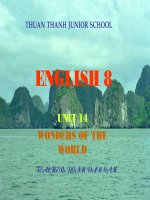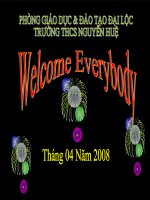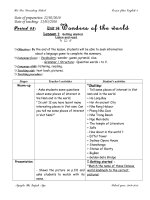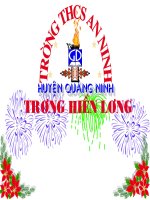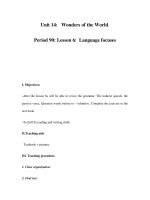Unit 14: Wonders of the world Lesson 4: READ (P134)+ LANGUAGE FOCUS 1 (P136)
Bạn đang xem bản rút gọn của tài liệu. Xem và tải ngay bản đầy đủ của tài liệu tại đây (2.28 MB, 13 trang )
Tr¬nghiÒnl¬ng
I. Aims.
-
Listening and reading a dialogue for detail information about a weather forecast.
II. Objectives.
By the end of the lesson, Ss wil be able to:
-
Get to know and use new words about weather.
-
Understand the information in a weather forcast.
-
Know how to study with modern equipments.
III. Materials
1. Teacher.
a. Hardware.
-Computer, Laptop.
b. Software:
- Microsoft office powerpoint 2003.
c. Others:
-Testbook, cassette, posters, pictures about weather.
2. Students
- Testbook, posters, vocabulary review about weather.
Period 86 Unit 14: Wonders of the world
Lesson 4: READ (P134)+ LANGUAGE FOCUS 1 (P136)
Unit 14: WONDERS OF THE WORLD
P 86: Lesson 4. Read + Language focus 1(Passive forms)
P 84: Lesson 2. Speak + Language focus 2 (Indirect questions with if and whether).
P 83: Lesson 1. listen and repeat+ Language focus 3(Question words before to-inf).
P 85: Lesson 3. Listen + Language focus 4 (Verb + to-infinitive).
P 87: Lesson 5. Write
Matching
A
B
C
D
E
F
Hanging gardens of Babylon
The Taj Mahal
The Pyramid of Cheops
The Great Wall
Angkor Wat
The Statue of Zeus
Cambodia
Iraq
Egypt
Greece
India
China
I. Pre-reading
-(to) compile
- God
- Religion (n)
religious (adj.)
- Royal
the royal capital city
biên soạn
khẳng định
-(to) claim
vị thần
tôn giáo
hoàng tộc
-(to) honor
tôn kính
Period 86 Unit 14: Wonders of the world
Lesson 4: READ (P134)+ LANGUAGE FOCUS 1 (P136)
1. Newwords
What and Where
claim
honor
God
religion
royal
compile
6
5
4
3
2
1
Period 86 Unit 14: Wonders of the world
Lesson 4: READ (P134)+ LANGUAGE FOCUS 1 (P136)
I. Pre-reading
* Checking newwords
2. True/false prediction:II. Pre-reading:
No Statements Guess
(G1)
Guess
(G2)
Corrections
1
An Egyptian man compile a list of what he thought were the seven
wonders of the world.
2
The only surviving wonder is The Pyramid of Cheeps in Egypt.
3
Today,we can still see the Hanging Gardens of Babylon in present-day
Iraq
4
Angkor Wat was originally built to honor a Hindu God.
5
The Great wall of China first wasn’t in the list of the 7 wonders of the
world.
6 In the early 15
th
century, the Khmer King chose Angkor Wat as the new
capital.
F
F
T
T
F
T
Period 86 Unit 14: Wonders of the world
Lesson 4: READ (P134)+ LANGUAGE FOCUS 1 (P136)
I. Pre-reading
II. While-reading
Read the text:
Centuries ago in Ancient Greece, a man by the name of
Antipater of Sidon compiled a list of what he thoungt
were the seven wonders of the world. The seven included
the Hanging gardens of Babylon in present-day Iraq, the
Statue of Zeus in Greece, and the Piramid of Cheops. The
pyramid is the only wonder you can see today.
Many people claim that there were othe wonder, which
the ancient Greeks knew nothing about. These include the
Great Wall of China, the Taj Mahal in India and Angkor
in Cambodia.
Angkor Wat should really be known as a wonder
because it is the largest temple in the world. The temple
was built around the year 1100 to honor a Hindu God, but
over the next three centuries it because a Buddhist
religious center. The area surrounding the temple, Angkor
Thom, used to be the royal capital city.
In the early 15
th
century, the Khmer rulers moved to
Phnom Penh and Angkor was quite. It now is a famous
tourist attraction.
Angkor Wat
Period 86 Unit 14: Wonders of the world
Lesson 4: READ (P134)+ LANGUAGE FOCUS 1 (P136)
I. Pre-reading
Checking prediction:
II. Pre-reading:
No Statements Guess
(G1)
Guess
(G2)
Corrections
1
man compile a list of
what he thought were the seven
wonders of the world.
2
The only surviving wonder is The
Pyramid of Cheeps in Egypt.
3
Today,we still see the Hanging
Gardens of Babylon in present-day
Iraq
4
Angkor Wat was originally built to
honor a Hindu God.
5
The Great wall of China first wasn’t
in the list of the 7 wonders of the
world.
6 In the early 15
th
century, the Khmer
King chose as the
new capital.
F
F
T
T
F
T
Centuries ago in Ancient Greece, a
man by the name of Antipater of Sidon
compiled a list of what he thoungt were
the seven wonders of the world. The
seven included the Hanging gardens of
Babylon in present-day Iraq, the Statue
of Zeus in Greece, and the Piramid of
Cheops. The pyramid is the only wonder
you can see today.
Many people claim that there were
othe wonder, which the ancient Greeks
knew nothing about. These include the
Great Wall of China, the Taj Mahal in
India and Angkor in Cambodia.
Angkor Wat should really be known as
a wonder because it is the largest temple
in the world. The temple was built
around the year 1100 to honor a Hindu
God, but over the next three centuries it
because a Buddhist religious center. The
area surrounding the temple, Angkor
Thom, used to be the royal capital city.
In the early 15
th
century, the Khmer
rulers moved to Phnom Penh and
Angkor was quite. It now is a famous
tourist attraction.
can’tcan
A GreeccAn Egyptian
Phnom PenhAngkor Wat
Period 86 Unit 14: Wonders of the world
Lesson 4: READ (P134)+ LANGUAGE FOCUS 1 (P136)
I. Pre-reading
a-The only surviving wonder on Antipater’s list is……
A-the Great Wall of China
B-the Statue of Zeus
C-the Pyramind of Cheops
D-Angkor Wat
b-Angkor Wat was originally built for……
A-Hindus C-Kings
B-Buddhists D-the citizens of Phnom Penh
c-Angkor Wat ……………
A-was a small temple
B-is one of the seven wonders of the world
C-is a Pyramid
D-was part of a royal Khmer city a long time ago
d-In the 1400s, the Khmer King………………….
A-built Angkor Was
B-chose Phnom Penh as the new capital
C-turned Angkor Wat into a Buddhist center
D-moved the temple to Phnom Penh
II. While-reading
1. Read the text and complete the sentences
Centuries ago in Ancient Greece, a man by
the name of Antipater of Sidon compiled a
list of what he thoungt were the seven
wonders of the world. The seven included the
Hanging gardens of Babylon in present-day
Iraq, the Statue of Zeus in Greece, and the
Piramid of Cheops. The pyramid is the only
wonder you can see today.
Many people claim that there were othe
wonder, which the ancient Greeks knew
nothing about. These include the Great Wall
of China, the Taj Mahal in India and Angkor
in Cambodia.
Angkor Wat should really be known as a
wonder because it is the largest temple in the
world. The temple was built around the year
1100 to honor a Hindu God, but over the next
three centuries it because a Buddhist
religious center. The area surrounding the
temple, Angkor Thom, used to be the royal
capital city.
In the early 15
th
century, the Khmer rulers
moved to Phnom Penh and Angkor was quite.
It now is a famous tourist attraction.
the Pyramind of Cheops
Hindus
was part of a royal Khmer city a long time ago
chose Phnom Penh as the new capital
Period 86 Unit 14: Wonders of the world
Lesson 4: READ (P134)+ LANGUAGE FOCUS 1 (P136)
I. Pre-reading
When was Angkor Wat built ?
It was built around the year 1100.
Past Simple
Passive form
Completed / 1973
Period 86 Unit 14: Wonders of the world
Lesson 4: READ (P134)+ LANGUAGE FOCUS 1 (P136)
Angkor Wat
II. While-reading
2. Model sentences:
in
a. Form:
To talk about the passive in the pastb. Usage:
S + was/were + V(ed/III) + O + by …
c. Ex:
The Statue of liberty was designed by a French.
d. Note:
was
were
We/ You / They
I / He / She / It
I. Pre-reading
1.Complete the sentences. Use the passive form of the verbs in the box.
construct reach present complete design
a) Sydney Opera House ……………… in 1973.
b) The first and longest section of the Great Wall of
China between 221 and 204 BC
c) The Eiffel Tower by the French civil engineer
Alexander Gustave Eiffel for the Paris World’s Fair of 1889.
d) The Statue of Liberty to the United States by
France in 1876.
e) The summit of Mount Everest by two members
of a British expedition and a Nepalese guide on May 29, 1953.
was d
was ed
was
ed
was ed
was ed
Period 86 Unit 14: Wonders of the world
Lesson 4: READ (P134)+ LANGUAGE FOCUS 1 (P136)
III. Post-reading
I. Pre-reading
II. While-reading
Period 86 Unit 14: Wonders of the world
Lesson 4: READ (P134)+ LANGUAGE FOCUS 1 (P136)
III. Post-reading
I. Pre-reading
II. While-reading
IV. Homework



